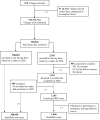Snakebite incidence and healthcare-seeking behaviors in Eastern Province, Rwanda: A cross-sectional study - PubMed (original) (raw)
Snakebite incidence and healthcare-seeking behaviors in Eastern Province, Rwanda: A cross-sectional study
Dieudonne Hakizimana et al. PLoS Negl Trop Dis. 2024.
Abstract
Background: Snakebite envenoming (SBE) is a potentially life-threatening event that can lead to severe physical, mental, and economic hardships, particularly in under-resourced regions like sub-Saharan Africa. In Rwanda, there have been no epidemiological assessments of SBE to guide the Ministry of Health in its efforts to reduce the burden. This study had two main objectives: first, to estimate the incidence of snakebites across districts, and second, to describe formal versus informal healthcare seeking behaviors among snakebite victims in Eastern Province, Rwanda in 2020.
Methodology: This cross-sectional study utilized a cluster sampling approach, involving Community Health Workers (CHWs) who recorded snakebite cases across seven districts. The descriptive analysis considered sampling weights, and healthcare seeking behavior was assessed based on the type of care sought as the first point of treatment.
Findings: The study surveyed 390,546 individuals across 763 villages and estimated a provincial annual incidence rate of 4.3 cases per 1,000 individuals. Incidence estimates ranged from 1.1 cases per 1,000 in Nyagatare to 9.1 cases per 1,000 individuals in Bugesera and Ngoma districts. Among the 2,545 cases recorded by CHWs, three resulted in deaths. Regarding healthcare-seeking behavior, 13% of snakebite victims (143 out of 1,098) initially consulted formal care providers (CHWs, health post/center, or hospital), while 87% sought informal care (family/friends, pharmacist, or traditional healer). Approximately half of the victims (583, 53.1%) reported severe symptoms. Unsafe practices included skin cutting/burning, tourniquet application, use of black stones, and venom extraction; only 24 cases (2.2%) received anti-venom.
Conclusions: This large-scale community-based assessment highlights variations in snakebite incidence between districts and confirms frequent involvement of traditional healers in management. Improving access to anti-venom and community education on the risks of ineffective practices, along with timely use of formal healthcare, are crucial. Collaboration between healthcare providers, traditional healers, community leaders, and policymakers is essential to implement targeted interventions for enhancing snakebite prevention and management strategies.
Copyright: © 2024 Hakizimana et al. This is an open access article distributed under the terms of the Creative Commons Attribution License, which permits unrestricted use, distribution, and reproduction in any medium, provided the original author and source are credited.
Conflict of interest statement
The authors have declared that no competing interests exist.
Figures
Fig 1. Map displaying selected sectors in Eastern Province (3 sectors per district).
The map was created by the author (DH) utilizing ArcMap 18.8.2. Its base layer comprises shapefiles sourced from the National Institute of Statistics of Rwanda and also publicly accessible via The World Bank (License: Creative Commons Attribution 4.0):
https://datacatalog.worldbank.org/search/dataset/0041453/Rwanda-Admin-Boundaries-and-Villages
.
Fig 2. Data collection flow chart.
Fig 3. Movement of snakebite patients between formal and informal care systems and reasons for choosing care in Eastern Province, Rwanda in 2020.
Similar articles
- Qualitative evidence synthesis informing our understanding of people's perceptions and experiences of targeted digital communication.
Ryan R, Hill S. Ryan R, et al. Cochrane Database Syst Rev. 2019 Oct 23;10(10):ED000141. doi: 10.1002/14651858.ED000141. Cochrane Database Syst Rev. 2019. PMID: 31643081 Free PMC article. - Falls prevention interventions for community-dwelling older adults: systematic review and meta-analysis of benefits, harms, and patient values and preferences.
Pillay J, Gaudet LA, Saba S, Vandermeer B, Ashiq AR, Wingert A, Hartling L. Pillay J, et al. Syst Rev. 2024 Nov 26;13(1):289. doi: 10.1186/s13643-024-02681-3. Syst Rev. 2024. PMID: 39593159 Free PMC article. - Tobacco Product Use and Associated Factors Among Middle and High School Students - National Youth Tobacco Survey, United States, 2021.
Gentzke AS, Wang TW, Cornelius M, Park-Lee E, Ren C, Sawdey MD, Cullen KA, Loretan C, Jamal A, Homa DM. Gentzke AS, et al. MMWR Surveill Summ. 2022 Mar 11;71(5):1-29. doi: 10.15585/mmwr.ss7105a1. MMWR Surveill Summ. 2022. PMID: 35271557 Free PMC article. - Depressing time: Waiting, melancholia, and the psychoanalytic practice of care.
Salisbury L, Baraitser L. Salisbury L, et al. In: Kirtsoglou E, Simpson B, editors. The Time of Anthropology: Studies of Contemporary Chronopolitics. Abingdon: Routledge; 2020. Chapter 5. In: Kirtsoglou E, Simpson B, editors. The Time of Anthropology: Studies of Contemporary Chronopolitics. Abingdon: Routledge; 2020. Chapter 5. PMID: 36137063 Free Books & Documents. Review. - Interventions for supporting pregnant women's decision-making about mode of birth after a caesarean.
Horey D, Kealy M, Davey MA, Small R, Crowther CA. Horey D, et al. Cochrane Database Syst Rev. 2013 Jul 30;2013(7):CD010041. doi: 10.1002/14651858.CD010041.pub2. Cochrane Database Syst Rev. 2013. PMID: 23897547 Free PMC article. Review.
Cited by
- Snakebite envenoming in Africa remains widely neglected and demands multidisciplinary attention.
Berg P, Theart F, van Driel M, Saaiman EL, Mavoungou LB. Berg P, et al. Nat Commun. 2024 Nov 6;15(1):9598. doi: 10.1038/s41467-024-54070-y. Nat Commun. 2024. PMID: 39505859 Free PMC article.
References
- World Health Organization. Snakebite envenoming [Internet]. World Health Organization (WHO). 2019. [cited 2019 Aug 23]. Available from: https://www.who.int/news-room/fact-sheets/detail/snakebite-envenoming
MeSH terms
Substances
LinkOut - more resources
Full Text Sources


